BioBestrijding | Parasitic Wasp Against Moths ~ Trichogramma Parasitic Wasps
BioBestrijding Parasitic Wasp against Moths
Attention! This product consists of live animals and is only available for order in the Netherlands or Belgium. If you order more than just Bio Fight, there will be an additional charge of € 7.95 due to dropshipping from the supplier.
With the help of the Trichogramma parasitic wasps you can control several moths. The parasitic wasps parasitize the eggs of the moths and thus prevent a moth egg from developing into a caterpillar. The wasp simply lays an egg in the egg of a moth, then after about 10 days an ichneumon wasp is born that will also lay eggs in the eggs of moths. This cycle repeats itself as long as there are moth eggs present. The use of Trichogramma parasitic wasps has proven successful in various studies and trials. A reduction in the number of caterpillars and moths can be achieved with the proper deployment of Trichogramma parasitic wasps.
The parasitic wasps are delivered on a hanging card containing 2,000 parasitic wasp eggs. This is sufficient for approximately 15 square meters. It is advised to repeat the treatment after 2 weeks. It concerns the following parasitic wasps that are in this mix: T. brassicae, T. evanescens, T. cacoeciae, T. dendrolimi.
Effective against the following moths, among others:
- Opogona sacchari
- Duponchelia fovealis
- Ostrinia nubialis
- Cacoecimorpha pronubana (carnation leaf roller)
- Autographa gamma (gamma owl)
- Lacanobia oleracea (vegetable owl)
- Mamestra brassicae (cabbage owl)
- Pieris brassicae
- Pieris rapae
- Chrysodeixis chalcites (turkey moth)
- Tineola bisselliella (clothes moth)
- Plodia interpunctella (feeding/stocking moth)
Temperature and Humidity
The parasitic wasps are very small, barely perceptible to the eye. Think of small fruit flies. These parasitic wasps only target moth eggs, leaving humans and animals alone. You can therefore safely release them into the bedroom, living room or other indoor rooms. Remember that the parasitic wasps are very sensitive to heat. The parasitic wasps develop from 15 degrees. Normally it takes about 10 days for the eggs to hatch but this is highly dependent on temperature. Optimal for the development is sun 23-28 degrees, the warmer the better but above 32-33 degrees it is too hot.
Wasp against moths
There are several environments in which the parasitic wasps can play a role in the control of moths. You can think of:
- In the (glass) horticulture in crops where moths occur
- In the production of textiles, fabrics, carpets, wool, upholstery etc.
- In stores that sell carpets, textiles, clothing, wool etc.
- In the closet at home (moths in your clothes)
Use of Pheromone traps?
There are various moth traps for the control of moths. These moth traps are equipped with pheromone, a substance by which moth males are lured. Female moths are not lured by the pheromone. Another disadvantage is that each type of moth is attracted to a different pheromone. This makes it difficult to catch all moths with 1 pheromone trap. With the deployment of ichneumon wasps, you do not have this problem, the ichneumon wasp mix fights a wide range of moth eggs.
Parasitizing moth eggs
To locate moth host eggs, adult females use chemical and visual cues, such as egg shape and color. After finding a suitable egg, an experienced female tries to determine if the egg has been parasitized previously, using her oviposition and drum propagation (by tapping on the surface of the egg). Females also use drum lacing to determine the size and quality of the target egg, which determines the number of eggs the female will lay. A single female can parasitize up to 10 moth eggs per day.
Release instructions
- Hang the unopened cards containing the eggs on the plants.
- Be careful when hanging, don't crush the eggs.
- Spread the cards in shady places and make sure that no water can run into the packaging.
- Because the parasitic wasps are very small and light they are very sensitive to suction devices, etc. Therefore, do not release the parasitic wasps near an exhaust system.
Storage advice
Biological parasitic wasps are living animals and have a (very) short life span. They should therefore be introduced into the crop as soon as possible after receipt. Storage can negatively influence the quality and is only possible under the conditions mentioned below.
- Storage life: 1-2 days
- Storage temperature: 8-10C
- Store in the dark and flat



